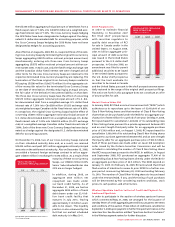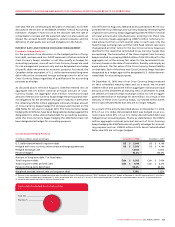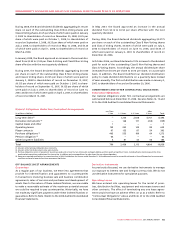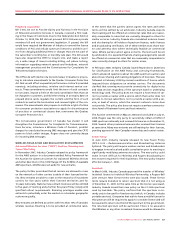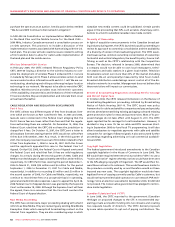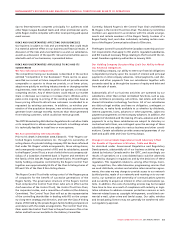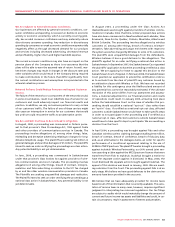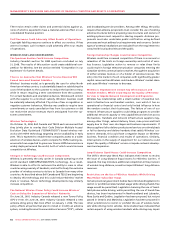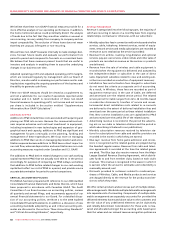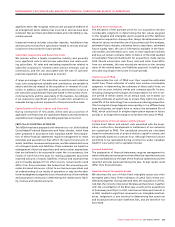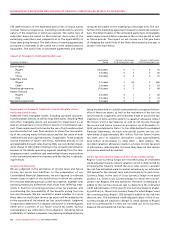Rogers 2008 Annual Report Download - page 64
Download and view the complete annual report
Please find page 64 of the 2008 Rogers annual report below. You can navigate through the pages in the report by either clicking on the pages listed below, or by using the keyword search tool below to find specific information within the annual report.
60 ROGERS COMMUNICATIONS INC. 2008 ANNUAL REPORT
MANAGEMENT’S DISCUSSION AND ANALYSIS OF FINANCIAL CONDITION AND RESULTS OF OPERATIONS
Industry Canada’s auction for AWS spectrum concluded on July
21, 2008. Each of the three large incumbent wireless operators,
Rogers, Bell Canada and TELUS, acquired spectrum licences of vary-
ing sizes and in varying markets across Canada. Rogers acquired
20 MHz of spectrum across the country, while Bell Canada and
TELUS each acquired a mix of 10 MHz and 20 MHz spectrum licences
across the country with the exception of Bell Canada in the Eastern
Townships, Québec licence territory, where Bell did not obtain spec-
trum. MTS Allstream Inc., and Saskatchewan Telecommunications
Holding Corporation acquired spectrum only in Manitoba and
Saskatchewan, respectively.
Through the auction, six new entrants acquired substantial regional
holdings of AWS spectrum, and several much smaller companies
acquired small amounts of spectrum in generally isolated locations.
These new entrants could provide Wireless with substantial com-
petition in the regions in which they have acquired licences. These
new entrants may also partner with one another or our other
competitors providing competition to Wireless in more than one
region or on a national scale. These new entrants are able to roam
on the networks of incumbent carriers for five years within their
licenced territories and for 10 years outside their licenced territo-
ries. Roaming privileges enable new entrants to potentially enter
the market on a broader geographic scale more quickly. Currently,
no single potential entrant has acquired spectrum sufficient to
become a national licencee as defined by Industry Canada to
qualify for mandated roaming on a national basis for 10 years. See
above under “Wireless Regulation and Regulatory Developments”
regarding Advanced Wireless Services (“AWS”) Auction, Roaming
and Tower/Site Policy.
Cable Competition
Canadian cable television systems generally face legal and ille-
gal competition from several alternative Canadian multi-channel
broadcasting distribution systems, illegal reception of U.S. direct
broadcast satellite services, terrestrially-based video service pro-
viders, satellite master antenna television, and multi-channel,
multi-point wireless distribution systems, as well as from the direct
reception by antenna of over-the-air local and regional broadcast
television signals. In addition, the availability of television shows
and movies on the Internet is increasingly becoming a direct com-
petitor to Canadian cable television systems.
Cable’s Internet access services compete generally with a number
of other Internet Service Providers (“ISPs”) offering competing
residential and commercial dial-up and high-speed Internet access
services. The Rogers Hi-Speed Internet services, where available,
compete directly with Bell’s DSL Internet service in the Internet
market in Ontario, with the DSL Internet services of Aliant in New
Brunswick and Newfoundland and Labrador, and various DSL resell-
ers in local markets.
Rogers Retail competes with other DVD and video game sales and
rental store chains, as well as individually owned and operated outlets
and, more recently, on-line-based subscription rental services and ille-
gally downloaded movies and television shows as well as distributors
of copied DVDs. Competition is principally based on location, price
and availability of titles. Rogers Retail also competes with other retail
stores that sell wireless and video products of our competitors.
One of the biggest forces for potential change in the telecommu-
nications industry is the threat of substitution of the traditional
wireline video, voice and data services by new technologies.
Internet delivery is increasingly becoming a direct threat to voice
and video service delivery. Younger generations use the Internet as
a substitute for traditional wireline telephone and television ser-
vices. The use of mobile phones among younger generations has
resulted in some abandonment of wireline service. Wireless-only
households are increasing although the vast majority of homes
today continue to use standard home telephone service. In addi-
tion, wireless Internet service is increasing in popularity.
Media Competition
Broadcasting’s radio stations compete with the other stations in
their respective market areas as well as with other media, such as
newspapers, magazines, television, outdoor advertising, direct
mail marketing and the Internet. Competition within the radio
broadcasting industry occurs primarily in individual market areas,
amongst individual market stations. On a national level, Media’s
Broadcasting division competes generally with other larger radio
operators, which own and operate radio station clusters in markets
across Canada. Additionally, over the past several years the CRTC has
granted additional licences in various markets for the development
of new radio stations, which in turn provide additional competi-
tion to the established stations in the respective markets. Two new
licenced satellite subscription-based radio services now provide
competition to Broadcasting’s radio stations. New technologies,
such as on-line web information services, music downloading, MP3
players and on-line music streaming services, provide competition
for broadcasting radio stations’ audience share.
On a product level, The Shopping Channel competes with various
retail stores, catalog retailers, Internet retailers and direct mail
retailers. On a broadcasting level, The Shopping Channel competes
with other television channels for viewer attention and loyalty, and
particularly with infomercials selling products on television.
The Canadian magazine industry is highly-competitive, compet-
ing for both readers and advertisers. This competition comes from
other Canadian magazines and from foreign, mostly U.S., titles
that sell in significant quantities in Canada. In the past, the com-
petition from foreign titles has been restricted to competition for
readers as there have been restrictions on foreigners operating in
the Canadian magazine advertising market. These restrictions were
significantly reduced as a result of the enactment in 1999 of the
Foreign Publishers Advertising Services Act (Canada) and amend-
ments to the Canadian Tax Act. Increasing competition from U.S.
magazines for advertising revenues is expected in the coming years.
On-line information and entertainment websites compete with the
Canadian magazine publications for readership and revenue.
OMNI, Citytv and Sportsnet compete principally for viewers and
advertisers with television stations that broadcast in their local
markets. These include Canadian television stations as well as
U.S. border stations, specialty channels and increasingly with
other distant Canadian signals and U.S. border stations given the
time-shifting capacity available to digital subscribers. On-line infor-
mation and entertainment and video downloading compete with
OMNI, Citytv and Sportsnet for share of viewership.



